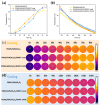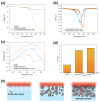Preparations and Thermal Properties of PDMS-AlN-Al2O3 Composites through the Incorporation of Poly(Catechol-Amine)-Modified Boron Nitride Nanotubes
- PMID: 38786803
- PMCID: PMC11123707
- DOI: 10.3390/nano14100847
Preparations and Thermal Properties of PDMS-AlN-Al2O3 Composites through the Incorporation of Poly(Catechol-Amine)-Modified Boron Nitride Nanotubes
Abstract
As one of the emerging nanomaterials, boron nitride nanotubes (BNNTs) provide promising opportunities for diverse applications due to their unique properties, such as high thermal conductivity, immense inertness, and high-temperature durability, while the instability of BNNTs due to their high surface induces agglomerates susceptible to the loss of their advantages. Therefore, the proper functionalization of BNNTs is crucial to highlight their fundamental characteristics. Herein, a simplistic low-cost approach of BNNT surface modification through catechol-polyamine (CAPA) interfacial polymerization is postulated to improve its dispersibility on the polymeric matrix. The modified BNNT was assimilated as a filler additive with AlN/Al2O3 filling materials in a PDMS polymeric matrix to prepare a thermal interface material (TIM). The resulting composite exhibits a heightened isotropic thermal conductivity of 8.10 W/mK, which is a ~47.27% increase compared to pristine composite 5.50 W/mK, and this can be ascribed to the improved BNNT dispersion forming interconnected phonon pathways and the thermal interface resistance reduction due to its augmented compatibility with the polymeric matrix. Moreover, the fabricated composite manifests a fire resistance improvement of ~10% in LOI relative to the neat composite sample, which can be correlated to the thermal stability shift in the TGA and DTA data. An enhancement in thermal permanence is stipulated due to a melting point (Tm) shift of ∼38.5 °C upon the integration of BNNT-CAPA. This improvement can be associated with the good distribution and adhesion of BNNT-CAPA in the polymeric matrix, integrated with its inherent thermal stability, good charring capability, and free radical scavenging effect due to the presence of CAPA on its surface. This study offers new insights into BNNT utilization and its corresponding incorporation into the polymeric matrix, which provides a prospective direction in the preparation of multifunctional materials for electric devices.
Keywords: boron nitride nanotubes; composites; fire retardant; polydimethylsiloxane; thermal conductivity; thermal interface materials.
Conflict of interest statement
Authors Arni Gesselle M. Pornea, Duy Khoe Dinh, Zahid Hanif, Numan Yanar, Ki-In Choi and Jaewoo Kim were employed by the company CMT Co., Ltd. The remaining authors declare that the research was conducted in the absence of any commercial or financial relationships that could be construed as a potential conflict of interest.
Figures








Similar articles
-
Enhancement of Isotropic Heat Dissipation of Polymer Composites by Using Ternary Filler Systems Consisting of Boron Nitride Nanotubes, h-BN, and Al2O3.ACS Omega. 2023 Jun 29;8(27):24454-24466. doi: 10.1021/acsomega.3c02246. eCollection 2023 Jul 11. ACS Omega. 2023. PMID: 37457480 Free PMC article.
-
Protruding Boron Nitride Nanotubes on the Al2O3 Surface Enabled by Tannic Acid-Assisted Modification to Fabricate a Thermal Conductive Epoxy/Al2O3 Composite.ACS Omega. 2024 Sep 5;9(37):38946-38956. doi: 10.1021/acsomega.4c05323. eCollection 2024 Sep 17. ACS Omega. 2024. PMID: 39310162 Free PMC article.
-
Tunable Piezoelectricity of Multifunctional Boron Nitride Nanotube/Poly(dimethylsiloxane) Stretchable Composites.Adv Mater. 2020 Oct;32(43):e2004607. doi: 10.1002/adma.202004607. Epub 2020 Sep 21. Adv Mater. 2020. PMID: 32954543
-
Boron nitride nanotubes: synthesis and applications.Nano Converg. 2018;5(1):17. doi: 10.1186/s40580-018-0149-y. Epub 2018 Jun 28. Nano Converg. 2018. PMID: 30046512 Free PMC article. Review.
-
Growth methodologies of boron nitride nanotubes and their neutron shielding applications: a review.Nanoscale. 2024 Feb 22;16(8):3817-3837. doi: 10.1039/d3nr06070e. Nanoscale. 2024. PMID: 38327235 Review.
References
-
- Ji X., Lu Z., Wang J., Ye N., Zhang H., Zhou L., Li J., Lu Y. Construction of Micro-Nano Hybrid Structure Based on Carbon Nanotube Whisker and Alumina for Thermally Conductive yet Electrically Insulating Silicone Rubber Composites. Compos. Sci. Technol. 2024;249:110495. doi: 10.1016/j.compscitech.2024.110495. - DOI
-
- Han G., Zhao X., Feng Y., Ma J., Zhou K., Shi Y., Liu C., Xie X. Highly Flame-Retardant Epoxy-Based Thermal Conductive Composites with Functionalized Boron Nitride Nanosheets Exfoliated by One-Step Ball Milling. Chem. Eng. J. 2021;407:127099. doi: 10.1016/j.cej.2020.127099. - DOI
-
- Yu B., Xing W., Guo W., Qiu S., Wang X., Lo S., Hu Y. Thermal Exfoliation of Hexagonal Boron Nitride for Effective Enhancements on Thermal Stability, Flame Retardancy and Smoke Suppression of Epoxy Resin Nanocomposites: Via Sol-Gel Process. J. Mater. Chem. A Mater. 2016;4:7330–7340. doi: 10.1039/c6ta01565d. - DOI
-
- Feng Y., Hu J., Xue Y., He C., Zhou X., Xie X., Ye Y., Mai Y.W. Simultaneous Improvement in the Flame Resistance and Thermal Conductivity of Epoxy/Al2O3 Composites by Incorporating Polymeric Flame Retardant-Functionalized Graphene. J. Mater. Chem. A Mater. 2017;5:13544–13556. doi: 10.1039/c7ta02934a. - DOI
Grants and funding
LinkOut - more resources
Full Text Sources
Research Materials

